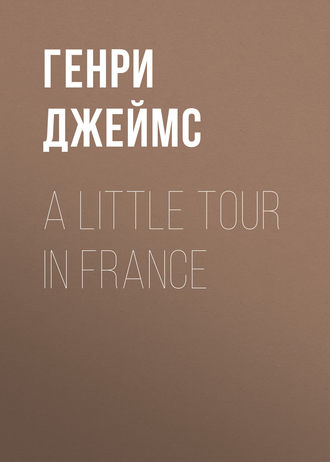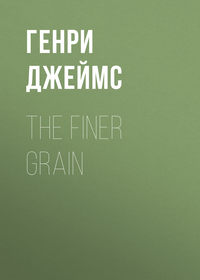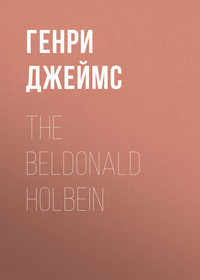 полная версия
полная версияA Little Tour in France
In the same street, on the other side, a little below, is something better worth your visit than the shrine of Saint Martin. Knock at a high door in a white wall (there is a cross above it), and a fresh-faced sister of the convent of the Petit Saint Martin will let you into the charming little cloister, or rather fragment of a cloister. Only one side of this exqui- site structure remains, but the whole place is effective. In front of the beautiful arcade, which is terribly bruised and obliterated, is one of those walks of inter- laced tilleuls which are so frequent in Touraine, and into which the green light filters so softly through a lattice of clipped twigs. Beyond this is a garden, and beyond the garden are the other buildings of the Convent, – where the placid sisters keep a school, – a test, doubtless, of placidity. The imperfect arcade, which dates from the beginning of the sixteenth cen- tury (I know nothing of it but what is related in Mrs. Pattison's "Rennaissance in France") is a truly en- chanting piece of work; the cornice and the angles of the arches, being covered with the daintiest sculpture of arabesques, flowers, fruit, medallions, cherubs, griffins, all in the finest and most attenuated relief. It is like the chasing of a bracelet in stone. The taste, the fancy, the elegance, the refinement, are of those things which revive our standard of the exquisite. Such a piece of work is the purest flower of the French Renaissance; there is nothing more delicate in all Touraine.
There is another fine thing at Tours which is not particularly delicate, but which makes a great impres- sion, – the- very interesting old church of Saint Julian, lurking in a crooked corner at the right of the Rue Royale, near the point at which this indifferent thorough- fare emerges, with its little cry of admiration, on the bank of the Loire. Saint Julian stands to-day in a kind of neglected hollow, where it is much shut in by houses; but in the year 1225, when the edifice was begun, the site was doubtless, as the architects say, more eligible. At present, indeed, when once you have caught a glimpse of the stout, serious Romanesque tower, – which is not high, but strong, – you feel that the building has something to say, and that you must stop to listen to it. Within, it has a vast and splendid nave, of immense height, – the nave of a cathedral, – with a shallow choir and transepts, and some admir- able old glass. I spent half an hour there one morn- ing, listening to what the church had to say, in perfect solitude. Not a worshipper entered, – not even an old man with a broom. I have always thought there is a sex in fine buildings; and Saint Julian, with its noble nave, is of the gender of the name of its patron.
It was that same morning, I think, that I went in search of the old houses of Tours; for the town con- tains several goodly specimens of the domestic archi- tecture of the past. The dwelling to which the average Anglo-Saxon will most promptly direct his steps, and the only one I have space to mention, is the so-called Maison de Tristan l'Hermite, – a gentleman whom the readers of "Quentin Durward" will not have forgotten, – the hangman-in-ordinary to the great King Louis XI. Unfortunately the house of Tristan is not the house of Tristan at all; this illusion has been cruelly dispelled. There are no illusions left, at all, in the good city of Tours, with regard to Louis XI. His terrible castle of Plessis, the picture of which sends a shiver through the youthful reader of Scott, has been reduced to sub- urban insignificance; and the residence of his triste compere, on the front of which a festooned rope figures as a motive for decoration, is observed to have been erected in the succeeding century. The Maison de Tristan may be visited for itself, however, if not for Walter Scott; it is an exceedingly picturesque old facade, to which you pick your way through a narrow and tortuous street, – a street terminating, a little be- yond it, in the walk beside the river. An elegant Gothic doorway is let into the rusty-red brick-work, and strange little beasts crouch at the angles of the windows, which are surmounted by a tall graduated gable, pierced with a small orifice, where the large surface of brick, lifted out of the shadow of the street, looks yellow and faded. The whole thing is disfigured and decayed; but it is a capital subject for a sketch in colors. Only I must wish the sketcher better luck – or a better temper – than my own. If he ring the bell to be admitted to see the court, which I believe is more sketchable still, let him have patience to wait till the bell is answered. He can do the outside while they are coming.
The Maison de Tristan, I say, may be visited for itself; but I hardly know what the remnants of Plessis- les-Tours may be visited for. To reach them you wander through crooked suburban lanes, down the course of the Loire, to a rough, undesirable, incon- gruous spot, where a small, crude building of red brick is pointed out to you by your cabman (if you happen to drive) as the romantic abode of a super- stitious king, and where a strong odor of pigsties and other unclean things so prostrates you for the moment that you have no energy to protest against the obvious fiction. You enter a yard encumbered with rubbish and a defiant dog, and an old woman emerges from a shabby lodge and assures you that you are indeed in an historic place. The red brick building, which looks like a small factory, rises on the ruins of the favorite residence of the dreadful Louis. It is now occupied by a company of night-scavengers, whose huge carts are drawn up in a row before it. I know not whether this be what is called the irony of fate; at any rate, the effect of it is to accentuate strongly the fact (and through the most susceptible of our senses) that there is no honor for the authors of great wrongs. The dreadful Louis is reduced simply to an offence to the nostrils. The old woman shows you a few fragments, – several dark, damp, much-encumbered vaults, de- nominated dungeons, and an old tower staircase, in good condition. There are the outlines of the old moat; there is also the outline of the old guard-room, which is now a stable; and there are other vague out- lines and inconsequent lumps, which I have forgotten. You need all your imagination, and even then you cannot make out that Plessis was a castle of large ex- tent, though the old woman, as your eye wanders over the neighboring potagers, talks a good deal about the gardens and the park. The place looks mean and flat; and as you drive away you scarcely know whether to be glad or sorry that all those bristling horrors have been reduced to the commonplace.
A certain flatness of impression awaits you also, I think, at Marmoutier, which is the other indisuensable excursion in the near neighborhood of Tours. The remains of this famous abbey lie on the other bank of the stream, about a mile and a half from the town. You follow the edge of the big brown river; of a fine afternoon you will be glad to go further still. The abbey has gone the way of most abbeys; but the place is a restoration as well as a ruin, inasmuch as the sisters of the Sacred Heart have erected a terribly modern convent here. A large Gothic doorway, in a high fragment of ancient wall, admits you to a garden- like enclosure, of great extent, from which you are further introduced into an extraordinarily tidy little parlor, where two good nuns sit at work. One of these came out with me, and showed me over the place, – a very definite little woman, with pointed features, an intensely distinct enunciation, and those pretty man- ners which (for whatever other teachings it may be responsible) the Catholic church so often instils into its functionaries. I have never seen a woman who had got her lesson better than this little trotting, murmur- ing, edifying nun. The interest, of Marmoutier to-day is not so much an interest of vision, so to speak, as an interest of reflection, – that is, if you choose to reflect (for instance) upon the wondrous legend of the seven sleepers (you may see where they lie in a row), who lived together – they were brothers and cousins – in primitive piety, in the sanctuary constructed by the blessed Saint Martin (emulous of his precursor, Saint Gatianus), in the face of the hillside that overhung the Loire, and who, twenty-five years after his death, yielded up their seven souls at the same moment, and enjoyed the curious privilege of retaining in their faces, in spite of this process, the rosy tints of life. The abbey of Marmoutier, which sprung from the grottos in the cliff to which Saint Gatianus and Saint Martin re- tired to pray, was therefore the creation of the latter worthy, as the other great abbey, in the town proper, was the monument of his repose. The cliff is still there; and a winding staircase, in the latest taste, en- ables you conveniently to explore its recesses. These sacred niches are scooped out of the rock, and will give you an impression if you cannot do without one. You will feel them to be sufficiently venerable when you learn that the particular pigeon-hole of Saint Gatianus, the first Christian missionary to Gaul, dates from the third century. They have been dealt with as the Catholic church deals with most of such places to- day; polished and furnished up; labelled and ticketed, – edited, with notes, in short, like an old book. The process is a mistake, – the early editions had more sanctity. The modern buildings (of the Sacred Heart), on which you look down from these points of vantage, are in the vulgar taste which seems doomed to stamp itself on all new Catholic work; but there was never- theless a great sweetness in the scene. The afternoon was lovely, and it was flushing to a close. The large garden stretched beneath us, blooming with fruit and wine and succulent vegetables, and beyond it flowed the shining river. The air was still, the shadows were long, and the place, after all, was full of memories, most of which might pass for virtuous. It certainly was better than Plessis-les-Tours.
IV
Your business at Tours is to make excursions; and if you make them all, you will be very well occupied. Touraine is rich in antiquities; and an hour's drive from the town in almost any direction will bring you to the knowledge of some curious fragment of domestic or ecclesiastical architecture, some turreted manor, some lonely tower, some gabled village, or historic site. Even, however, if you do everything, – which was not my case, – you cannot hope to relate everything, and, fortunately for you, the excursions divide them- selves into the greater and the less. You may achieve most of the greater in a week or two; but a summer in Touraine (which, by the way must be a charming thing) would contain none too many days for the others. If you come down to Tours from Paris, your best economy is to spend a few days at Blois, where a clumsy, but rather attractive little inn, on the edge of the river, will offer you a certain amount of that familiar and intermittent hospitality which a few weeks spent in the French provinces teaches you to regard as the highest attainable form of accommodation. Such an economy I was unable to practise. I could only go to Blois (from Tours) to spend the day; but this feat I accomplished twice over. It is a very sympathetic little town, as we say nowadays, and one might easily resign one's self to a week there. Seated on the north bank of the Loire, it presents a bright, clean face to the sun, and has that aspect of cheerful leisure which belongs to all white towns that reflect, themselves in shining waters. It is the water-front only of Blois, however, that exhibits, this fresh complexion; the in- terior is of a proper brownness, as befits a signally historic city. The only disappointment I had there was the discovery that the castle, which is the special object of one's pilgrimage, does not overhang the river, as I had always allowed myself to understand. It overhangs the town, but it is scarcely visible from the stream. That peculiar good fortune is reserved for Amboise and Chaurnont.
The Chateau de Blois is one of the most beautiful and elaborate of all the old royal residences of this part of France, and I suppose it should have all the honors of my description. As you cross its threshold, you step straight into the brilliant movement of the French Renaissance. But it is too rich to describe, – I can only touch it here and there. It must be pre- mised that in speaking of it as one sees it to-day, one speaks of a monument unsparingly restored. The work of restoration has been as ingenious as it is pro- fuse, but it rather chills the imagination. This is perhaps almost the first thing you feel as you ap- proach the castle from the streets of the town. These little streets, as they, leave the river, have pretensions to romantic steepness; one of them, indeed, which resolves itself into a high staircase with divergent wings (the escalier monumental), achieved this result so successfully as to remind me vaguely – I hardly know why – of the great slope of the Capitol, beside the Ara Coeli, at Rome. The view of that part of the castle which figures to-day as the back (it is the only aspect I had seen reproduced) exhibits the marks of restoration with the greatest assurance. The long facade, consisting only of balconied windows deeply recessed, erects itself on the summit of a considerable hill, which gives a fine, plunging movement to its foundations. The deep niches of the windows are all aglow with color. They have been repainted with red and blue, relieved with gold figures; and each of them looks more like the royal box at a theatre than like the aperture of a palace dark with memories. For all this, however, and in spite of the fact that, as in some others of the chateaux of Touraine, (always excepting the colossal Chambord, which is not in Touraine!) there is less vastness than one had expected, the least hospitable aspect of Blois is abundantly impressive. Here, as elsewhere, lightness and grace are the key- note; and the recesses of the windows, with their happy proportions, their sculpture, and their color, are the empty frames of brilliant pictures. They need the figure of a Francis I. to complete them, or of a Diane de Poitiers, or even of a Henry III. The base of this exquisite structure emerges from a bed of light verdure, which has been allowed to mass itself there, and which contributes to the springing look of the walls; while on the right it joins the most modern portion of the castle, – the building erected, on founda- tions of enormous height and solidity, in 1635, by Gaston d'Orleans. This fine, frigid mansion – the proper view of it is from the court within – is one of the masterpieces of Francois Mansard, whom. a kind pro- vidence did not allow to make over the whole palace in the superior manner of his superior age. This had been a part of Gaston's plan, – he was a blunderer born, and this precious project was worthy of him. This execution of it would surely have been one of the great misdeeds of history. Partially performed, the misdeed is not altogether to be regretted; for as one stands in the court of the castle, and lets one's eye wander from the splendid wing of Francis I. – which is the last work of free and joyous invention – to the ruled lines and blank spaces of the ponderous pavilion of Mansard, one makes one's reflections upon the advantage, in even the least personaI of the arts, of having something to say, and upon the stupidity of a taste which had ended by becoming an aggregation of negatives. Gaston's wing, taken by itself, has much of the bel air which was to belong to the architecture of Louis XIV.; but, taken in contrast to its flowering, laughing, living neighbor, it marks the difference be- tween inspiration and calculation. We scarcely grudge it its place, however, for it adds a price to the rest of the chateau.
We have entered the court, by the way, by jump- ing over the walls. The more orthodox method is to follow a modern, terrace, which leads to the left, from the side of the chateau that I began by speaking of, and passes round, ascending, to a little square on a considerably higher level, which is not, like a very modern square on which the back (as I have called it) looks out, a thoroughfare. This small, empty place, oblong in form, at once bright and quiet, with a cer- tain grass-grown look, offers an excellent setting to the entrance-front of the palace, – the wing of Louis XII. The restoration here has been lavish; but it was per- haps but an inevitable reaction against the injuries, still more lavish, by which the unfortunate building had long been overwhelmed. It had fallen into a state of ruinous neglect, relieved only by the misuse pro- ceeding from successive generations of soldiers, for whom its charming chambers served as barrack-room. Whitewashed, mutilated, dishonored, the castle of Blois may be said to have escaped simply with its life. This is the history of Amboise as well, and is to a certain extent the history of Chambord. Delightful, at any rate, was the refreshed facade of Louis XII. as I stood and looked at it one bright September morning. In that soft, clear, merry light of Touraine, everything shows, everything speaks. Charming are the taste, the happy proportions, the color of this beautiful front, to which the new feeling for a purely domestic architec- ture – an architecture of security and tranquillity, in which art could indulge itself – gave an air of youth and gladness. It is true that for a long time to come the castle of Blois was neither very safe nor very quiet; but its dangers came from within, from the evil passions of its inhabitants, and not from siege or in- vasion. The front of Louis XII. is of red brick, crossed here and there with purple; and the purple slate of the high roof, relieved with chimneys beautifully treated, and with the embroidered caps of pinnacles and arches, with the porcupine of Louis, the ermine and the festooned rope which formed the devices of Anne of Brittany, – the tone of this rich-looking roof carries out the mild glow of the wall. The wide, fair windows look as if they had expanded to let in the rosy dawn of the Renaissance. Charming, for that matter, are the windows of all the chateaux of Touraine, with their squareness corrected (as it is not in the Tudor architecture) by the curve of the upper corners, which makes this line look – above the expressive aperture – like a pencilled eyebrow. The low door of this front is crowned by a high, deep niche, in which, under a splendid canopy, stiffly astride of a stiffly draped charger, sits in profile an image of the good King Louis. Good as he had been, – the father of his people, as he was called (I believe he remitted various taxes), – he was not good enough to pass muster at the Revolution; and the effigy I have just described is no more than a reproduction of the primitive statue demolished at that period.
Pass beneath it into the court, and the sixteenth century closes round you. It is a pardonable flight of fancy to say that the expressive faces of an age in which human passions lay very near the surface seem to look out at you from the windows, from the balconies, from the thick foliage of the sculpture. The portion of the wing of Louis XII. that looks toward the court is supported on a deep arcade. On your right is the wing erected by Francis I., the reverse of the mass of building which you see on approaching the castle. This exquisite, this extravagant, this trans- cendent piece of architecture is the most joyous ut- terance of the French Renaissance. It is covered with an embroidery of sculpture, in which every detail is worthy of the hand of a goldsmith. In the middle of it, or rather a little to the left, rises the famous wind- ing staircase (plausibly, but I believe not religiously, restored), which even the ages which most misused it must vaguely have admired. It forms a kind of chiselled cylinder, with wide interstices, so that the stairs are open to the air. Every inch of this structure, of its balconies, its pillars, its great central columns, is wrought over with lovely images, strange and ingenious devices, prime among which is the great heraldic sala- mander of Francis I. The salamander is everywhere at Blois, – over the chimneys, over the doors, on the walls. This whole quarter , of the castle bears the stamp of that eminently pictorial prince. The run- ning cornice along the top of the front is like all un- folded, an elongated, bracelet. The windows of the attic are like shrines for saints. The gargoyles, the medallions, the statuettes, the festoons, are like the elaboration of some precious cabinet rather than the details of a building exposed to the weather and to the ages. In the interior there is a profusion of res- toration, and it is all restoration in color. This has been, evidently, a work of great energy and cost, but it will easily strike you as overdone. The universal freshness is a discord, a false note; it seems to light up the dusky past with an unnatural glare. Begun in the reign of Louis Philippe, this terrible process – the more terrible always the more you admit that it has been necessary – has been carried so far that there is now scarcely a square inch of the interior that has the color of the past upon it. It is true that the place had been so coated over with modern abuse that something was needed to keep it alive; it is only, per- haps, a pity that the restorers, not content with saving its life, should have undertaken to restore its youth. The love of consistency, in such a business, is a dangerous lure. All the old apartments have been rechristened, as it were; the geography of the castle has been re-established. The guardrooms, the bed- rooms, the closets, the oratories, have recovered their identity. Every spot connected with the murder of the Duke of Guise is pointed out by a small, shrill boy, who takes you from room to room, and who has learned his lesson in perfection. The place is full of Catherine de' Medici, of Henry III., of memories, of ghosts, of echoes, of possible evocations and revivals. It is covered with crimson and gold. The fireplaces and the ceilings are magnificent; they look like ex- pensive "sets" at the grand opera.
I should have mentioned that below, in the court, the front of the wing of Gaston d'Orleans faces you as you enter, so that the place is a course of French history. Inferior in beauty and grace to the other portions of the castle, the wing is yet a nobler monu- ment than the memory of Gaston deserves. The second of the sons of Henry IV., – who was no more fortunate as a father than as a husband, – younger brother of Louis XIII., and father of the great Mademoiselle, the most celebrated, most ambitious, most self-complacent, and most unsuccessful fille a marier in French history, passed in enforced retirement at the castle of Blois the close of a life of clumsy intrigues against Cardinal Richelieu, in which his rashness was only equalled by his pusillanimity and his ill-luck by his inaccessibility to correction, and which, after so many follies and shames, was properly summed up in the project – be- gun, but not completed – of demolishing the beautiful habitation of his exile in order to erect a better one. With Gaston d'Orleans, however, who lived there with- out dignity, the history of the Chateau de Blois de- clines. Its interesting period is that of the wars of religion. It was the chief residence of Henry III., and the scene of the principal events of his depraved and dramatic reign. It has been restored more than enough, as I have said, by architects and decorators; the visitor, as he moves through its empty rooms, which are at once brilliant and ill-lighted (they have not been re- furnished), undertakes a little restoration of his own. His imagination helps itself from the things that re- main; he tries to see the life of the sixteenth century in its form and dress, – its turbulence, its passions, its loves and hates, its treacheries, falsities, touches of faith, its latitude of personal development, its presen- tation of the whole nature, its nobleness of costume, charm of speech, splendor of taste, unequalled pic- turesqueness. The picture is full of movement, of contrasted light and darkness, full altogether of abomi- nations. Mixed up with them all is the great name of religion, so that the drama wants nothing to make it complete. What episode was ever more perfect – looked at as a dramatic occurrence – than the murder of the Duke of Guise? The insolent prosperity of the victim; the weakness, the vices, the terrors, of the author of the deed; the perfect execution of the plot; the accu- mulation of horror in what followed it, – give it, as a crime, a kind of immortal solidity.









